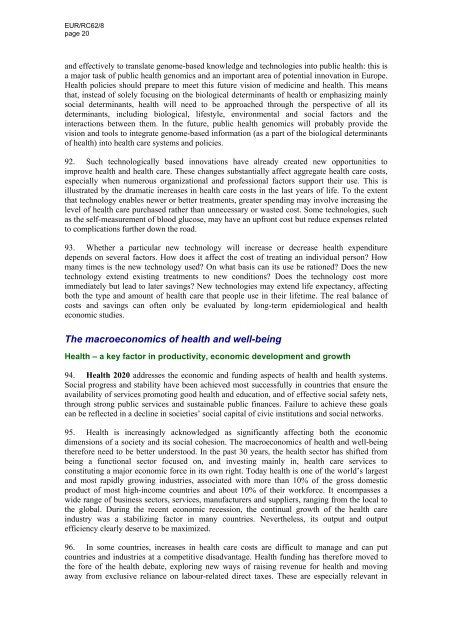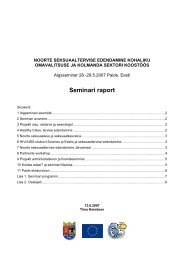EUR/RC62/wd08 (Eng) - WHO/Europe - World Health Organization
EUR/RC62/wd08 (Eng) - WHO/Europe - World Health Organization
EUR/RC62/wd08 (Eng) - WHO/Europe - World Health Organization
Create successful ePaper yourself
Turn your PDF publications into a flip-book with our unique Google optimized e-Paper software.
<strong>EUR</strong>/<strong>RC62</strong>/8<br />
page 20<br />
and effectively to translate genome-based knowledge and technologies into public health: this is<br />
a major task of public health genomics and an important area of potential innovation in <strong>Europe</strong>.<br />
<strong>Health</strong> policies should prepare to meet this future vision of medicine and health. This means<br />
that, instead of solely focusing on the biological determinants of health or emphasizing mainly<br />
social determinants, health will need to be approached through the perspective of all its<br />
determinants, including biological, lifestyle, environmental and social factors and the<br />
interactions between them. In the future, public health genomics will probably provide the<br />
vision and tools to integrate genome-based information (as a part of the biological determinants<br />
of health) into health care systems and policies.<br />
92. Such technologically based innovations have already created new opportunities to<br />
improve health and health care. These changes substantially affect aggregate health care costs,<br />
especially when numerous organizational and professional factors support their use. This is<br />
illustrated by the dramatic increases in health care costs in the last years of life. To the extent<br />
that technology enables newer or better treatments, greater spending may involve increasing the<br />
level of health care purchased rather than unnecessary or wasted cost. Some technologies, such<br />
as the self-measurement of blood glucose, may have an upfront cost but reduce expenses related<br />
to complications further down the road.<br />
93. Whether a particular new technology will increase or decrease health expenditure<br />
depends on several factors. How does it affect the cost of treating an individual person? How<br />
many times is the new technology used? On what basis can its use be rationed? Does the new<br />
technology extend existing treatments to new conditions? Does the technology cost more<br />
immediately but lead to later savings? New technologies may extend life expectancy, affecting<br />
both the type and amount of health care that people use in their lifetime. The real balance of<br />
costs and savings can often only be evaluated by long-term epidemiological and health<br />
economic studies.<br />
The macroeconomics of health and well-being<br />
<strong>Health</strong> – a key factor in productivity, economic development and growth<br />
94. <strong>Health</strong> 2020 addresses the economic and funding aspects of health and health systems.<br />
Social progress and stability have been achieved most successfully in countries that ensure the<br />
availability of services promoting good health and education, and of effective social safety nets,<br />
through strong public services and sustainable public finances. Failure to achieve these goals<br />
can be reflected in a decline in societies’ social capital of civic institutions and social networks.<br />
95. <strong>Health</strong> is increasingly acknowledged as significantly affecting both the economic<br />
dimensions of a society and its social cohesion. The macroeconomics of health and well-being<br />
therefore need to be better understood. In the past 30 years, the health sector has shifted from<br />
being a functional sector focused on, and investing mainly in, health care services to<br />
constituting a major economic force in its own right. Today health is one of the world’s largest<br />
and most rapidly growing industries, associated with more than 10% of the gross domestic<br />
product of most high-income countries and about 10% of their workforce. It encompasses a<br />
wide range of business sectors, services, manufacturers and suppliers, ranging from the local to<br />
the global. During the recent economic recession, the continual growth of the health care<br />
industry was a stabilizing factor in many countries. Nevertheless, its output and output<br />
efficiency clearly deserve to be maximized.<br />
96. In some countries, increases in health care costs are difficult to manage and can put<br />
countries and industries at a competitive disadvantage. <strong>Health</strong> funding has therefore moved to<br />
the fore of the health debate, exploring new ways of raising revenue for health and moving<br />
away from exclusive reliance on labour-related direct taxes. These are especially relevant in









